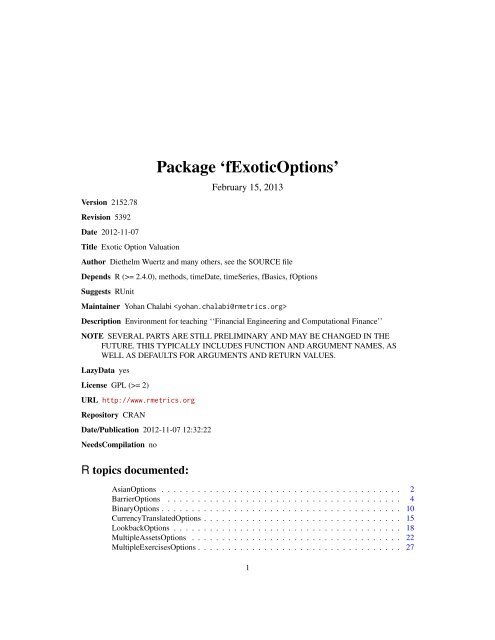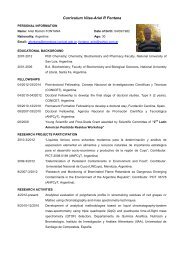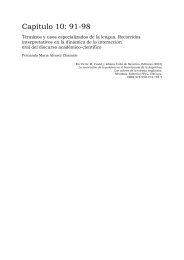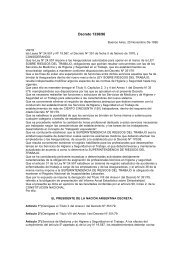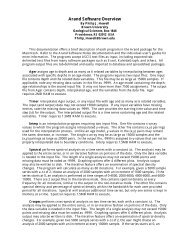Package 'fExoticOptions' - CRAN
Package 'fExoticOptions' - CRAN
Package 'fExoticOptions' - CRAN
Create successful ePaper yourself
Turn your PDF publications into a flip-book with our unique Google optimized e-Paper software.
Version 2152.78<br />
Revision 5392<br />
Date 2012-11-07<br />
Title Exotic Option Valuation<br />
<strong>Package</strong> ‘fExoticOptions’<br />
February 15, 2013<br />
Author Diethelm Wuertz and many others, see the SOURCE file<br />
Depends R (>= 2.4.0), methods, timeDate, timeSeries, fBasics, fOptions<br />
Suggests RUnit<br />
Maintainer Yohan Chalabi <br />
Description Environment for teaching ‘‘Financial Engineering and Computational Finance’’<br />
NOTE SEVERAL PARTS ARE STILL PRELIMINARY AND MAY BE CHANGED IN THE<br />
FUTURE. THIS TYPICALLY INCLUDES FUNCTION AND ARGUMENT NAMES, AS<br />
WELL AS DEFAULTS FOR ARGUMENTS AND RETURN VALUES.<br />
LazyData yes<br />
License GPL (>= 2)<br />
URL http://www.rmetrics.org<br />
Repository <strong>CRAN</strong><br />
Date/Publication 2012-11-07 12:32:22<br />
NeedsCompilation no<br />
R topics documented:<br />
AsianOptions . . . . . . . . . . . . . . . . . . . . . . . . . . . . . . . . . . . . . . . . 2<br />
BarrierOptions . . . . . . . . . . . . . . . . . . . . . . . . . . . . . . . . . . . . . . . 4<br />
BinaryOptions . . . . . . . . . . . . . . . . . . . . . . . . . . . . . . . . . . . . . . . . 10<br />
CurrencyTranslatedOptions . . . . . . . . . . . . . . . . . . . . . . . . . . . . . . . . . 15<br />
LookbackOptions . . . . . . . . . . . . . . . . . . . . . . . . . . . . . . . . . . . . . . 18<br />
MultipleAssetsOptions . . . . . . . . . . . . . . . . . . . . . . . . . . . . . . . . . . . 22<br />
MultipleExercisesOptions . . . . . . . . . . . . . . . . . . . . . . . . . . . . . . . . . . 27<br />
1
2 AsianOptions<br />
Index 33<br />
AsianOptions Valuation of Asian Options<br />
Description<br />
Usage<br />
This is a collection of functions to valuate Asian options. Asian options are path-dependent options,<br />
with payoffs that depend on the average price of the underlying asset or the average exercise price.<br />
There are two categories or types of Asian options: average rate options (also known as average<br />
price options) and average strike options. The payoffs depend on the average price of the underlying<br />
asset over a predetermined time period. An average is less volatile than the underlying asset,<br />
therefore making Asian options less expensive than standard European options. Asian options are<br />
commonly used in currency and commodity markets. Asian options are of interest in markets with<br />
thinly traded assets. Due to the little effect it will have on the option’s value, options based on<br />
an average, such as Asian options, have a reduced incentive to manipulate the underlying price at<br />
expiration.<br />
The functions are:<br />
GeometricAverageRateOption Geometric Average Rate Option,<br />
TurnbullWakemanAsianApproxOption Turnbull and Wakeman’s Approximation,<br />
LevyAsianApproxOption Levy’s Approximation.<br />
GeometricAverageRateOption(TypeFlag, S, X, Time, r, b, sigma,<br />
title = NULL, description = NULL)<br />
TurnbullWakemanAsianApproxOption(TypeFlag, S, SA, X, Time, time,<br />
tau, r, b, sigma, title = NULL, description = NULL)<br />
LevyAsianApproxOption(TypeFlag, S, SA, X, Time, time, r, b,<br />
sigma, title = NULL, description = NULL)<br />
Arguments<br />
b the annualized cost-of-carry rate, a numeric value; e.g. 0.1 means 10% pa.<br />
description a character string which allows for a brief description.<br />
r a numeric value, the annualized rate of interest; e.g. 0.25 means 25% pa.<br />
S, SA the asset price, a numeric value.<br />
sigma a numeric value, the annualized volatility of the underlying security; e.g. 0.3<br />
means 30% volatility pa.<br />
tau [TurnWakeAsianApprox*] -<br />
is the time to the beginning of the average period.<br />
time, Time a numeric value, the time to maturity measured in years; e.g. 0.5 means 6<br />
months.
AsianOptions 3<br />
Details<br />
Value<br />
Note<br />
title a character string which allows for a project title.<br />
TypeFlag a character string either "c" for a call option or a "p" for a put option.<br />
X the exercise price, a numeric value.<br />
The Geometric average is the nth root of the product of the n sample points. The Arithmetic average<br />
is the sum of the stock values divided by the number of sampling points. Although Geometric Asian<br />
options are not commonly used in practice, they are often used as a good initial guess for the price<br />
of arithmetic Asian options. This technique is used to improve the convergence rate of the Monte<br />
Carlo model when pricing arithmetic Asian options.<br />
Two cases are considered, the geometric and the arithmetic average-rate option. For the latter one<br />
can choose between three different kinds of approximations: Turnbull and Wakeman’s approximations,<br />
Levy’s approximation and Curran’s approximation.<br />
[Haug’s Book, Chapter 2.12]<br />
The option price, a numeric value.<br />
The functions implement the algorithms to valuate plain vanilla options as described in Chapter<br />
2.12 of Haug’s Book (1997).<br />
Author(s)<br />
Diethelm Wuertz for the Rmetrics R-port.<br />
References<br />
Haug E.G. (1997); The complete Guide to Option Pricing Formulas, Chapter 2.12, McGraw-Hill,<br />
New York.<br />
Examples<br />
## Examples from Chapter 2.12 in E.G. Haug’s Option Guide (1997)<br />
## Geometric Average Rate Option:<br />
GeometricAverageRateOption(TypeFlag = "p", S = 80, X = 85,<br />
Time = 0.25, r = 0.05, b = 0.08, sigma = 0.20)<br />
## Turnbull Wakeman Approximation:<br />
TurnbullWakemanAsianApproxOption(TypeFlag = "p", S = 90, SA = 88,<br />
X = 95, Time = 0.50, time = 0.25, tau = 0.0, r = 0.07,<br />
b = 0.02, sigma = 0.25)<br />
## Levy Asian Approximation:<br />
LevyAsianApproxOption(TypeFlag = "c", S = 100, SA = 100, X = 105,
4 BarrierOptions<br />
Time = 0.75, time = 0.50, r = 0.10, b = 0.05, sigma = 0.15)<br />
BarrierOptions Valuation of Barrier Options<br />
Description<br />
Usage<br />
A collection and description of functions to valuate barrier options. Barrier options are pathdependent<br />
options, with payoffs that depend on the price of the underlying asset at expiration and<br />
whether or not the asset price crosses a barrier during the life of the option. There are two categories<br />
or types of Barrier options: "knock-in" and "knock-out". "Knock-in" or "in" options are paid for<br />
up front, but you do not receive the option until the asset price crosses the barrier. "Knock-out"<br />
or "out" options come into existence on the issue date but becomes worthless if the asset price hits<br />
the barrier before the expiration date. If the option is a knock-in (knock-out), a predetermined cash<br />
rebate may be paid at expiration if the option has not been knocked in (knocked-out) during its<br />
lifetime. The barrier monitoring frequency specifies how often the price is checked for a breach of<br />
the barrier. All of the analytical models have a flag to change the monitoring frequency where the<br />
default frequency is continuous.<br />
The functions are:<br />
StandardBarrierOption Standard Barrier Option,<br />
DoubleBarrierOption Double Barrier Option,<br />
PTSingleAssetBarrierOption Partial Time Single Asset Barrier Option,<br />
TwoAssetBarrierOption Two Asset Barrier Option,<br />
PTTwoAssetBarrierOption Partial Time Two Asset Barrier Option,<br />
LookBarrierOption Lookback Barrier Option,<br />
DiscreteBarrierOption Discrete Barrier Option<br />
SoftBarrierOption Soft Barrier Option.<br />
StandardBarrierOption(TypeFlag, S, X, H, K, Time, r, b, sigma,<br />
title = NULL, description = NULL)<br />
DoubleBarrierOption(TypeFlag, S, X, L, U, Time, r, b, sigma,<br />
delta1, delta2, title = NULL, description = NULL)<br />
PTSingleAssetBarrierOption(TypeFlag, S, X, H, time1, Time2, r,<br />
b, sigma, title = NULL, description = NULL)<br />
TwoAssetBarrierOption(TypeFlag, S1, S2, X, H, Time, r, b1, b2,<br />
sigma1, sigma2, rho, title = NULL, description = NULL)<br />
PTTwoAssetBarrierOption(TypeFlag, S1, S2, X, H, time1, Time2, r,<br />
b1, b2, sigma1, sigma2, rho, title = NULL, description = NULL)<br />
LookBarrierOption(TypeFlag, S, X, H, time1, Time2, r, b, sigma,<br />
title = NULL, description = NULL)<br />
DiscreteBarrierOption(S, H, sigma, dt, title = NULL,<br />
description = NULL)
BarrierOptions 5<br />
SoftBarrierOption(TypeFlag, S, X, L, U, Time, r, b, sigma,<br />
title = NULL, description = NULL)<br />
Arguments<br />
b the annualized cost-of-carry rate, a numeric value; e.g. 0.1 means 10% pa.<br />
b1, b2 [PTTwoAssetBarrier*] -<br />
the annualized cost-of-carry rate for the first and second asset, a numeric value.<br />
delta1, delta2 [DoubleBarrier*] -<br />
numeric values which determine the curvature of the lower L and upper U bounds.<br />
The case of<br />
delta1=delta2=0 corresponds to two flat boundaries,<br />
delta1delta2 correponds to a convex downward lower boundary and a convex<br />
upward upper boundary.<br />
description a character string which allows for a brief description.<br />
dt [DiscreteBarrier*] -<br />
time between monitoring instants, a numeric value.<br />
H [StandardBarrier*] -<br />
the barrier value, a numeric value.<br />
K [StandardBarrier*] -<br />
for an "In"-Barrier a prespecified cash rebate which is paid out at option expiration<br />
if the option has not been knocked in during its lifetime,<br />
for an "Out"-Barrier a prespecified cash rebate which is paid out at option expiration<br />
if the option has not been knocked out before its lifetime, a numerical<br />
value.<br />
L, U [DoubleBarrier*] -<br />
the lower and upper boundary to be touched, numerical values.<br />
r the annualized rate of interest, a numeric value; e.g. 0.25 means 25% pa.<br />
rho [TwoAssetBarrier*] -<br />
the correlation of the volatility between the first and second asset, a numeric<br />
value.<br />
S the asset price, a numeric value.<br />
S1, S2 [PTTwoAssetBarrier*] -<br />
the price of the first and second asset, a numeric value.<br />
sigma the annualized volatility of the underlying security, a numeric value; e.g. 0.3<br />
means 30% volatility pa.<br />
sigma1, sigma2 [PTTwoAssetBarrier*] -<br />
the annualized volatility of the first and second underlying security, numeric<br />
values.<br />
Time the time to maturity measured in years, a numeric value; e.g. 0.5 means 6<br />
months.
6 BarrierOptions<br />
time1, Time2 [PTSingleAssetBarrier*][PTTwoAssetBarrier*] -<br />
so called type "A" options (see the TypeFlag argument) will have the location<br />
of the monitoring period starting at the options starting date and ending at an<br />
arbitrary time time1 before expiration time Time2. Partial-time-end-barrier options<br />
will have the location of the monitoring period starting at an arbitrary time<br />
time1 before expiration time Time2, and ending at expiration time.<br />
[LookBarrier*] -<br />
the lookbarrier option’s barrier monitoring period starts at the options starting<br />
date and ends at an arbitrary time time1 before expiration time Time2.<br />
title a character string which allows for a project title.<br />
TypeFlag usually a character string either "c" for a call option or a "p" for a put option.<br />
[StandardBarrier*] -<br />
here<br />
"cdi" denotes a down-and-in call,<br />
"cui" denotes an up-and-in call,<br />
"cdo" denotes a down-and-out call, and<br />
"cuo" denotes an up-and-out call.<br />
Similarily, the type flags for the corresponding puts are "pdi", "pui", "pdo",<br />
and "puo".<br />
[DoubleBarrier*] -<br />
here<br />
"co" denotes an up-and-out-down-and-out call,<br />
"ci" denotes an up-and-in-down-and-in call,<br />
"po" denotes an up-and-out-down-and-out put, and<br />
"pi" denotes an up-and-in-down-and-in call.<br />
[PTSingleAssetBarrier*] -<br />
here<br />
"cdoA" denotes a down-and-out call of type "A",<br />
"cuoA" denotes an up-and-out call of type "A",<br />
"pdoA" denotes a down-and-out put of type "A",<br />
"puoA" denotes an up-and-out put of type "A",<br />
"coB1" denotes an out-call of type "B1",<br />
"poB1" denotes an out-call of type "B1",<br />
"cdoB2" denotes a down-and-out call of type "B2",<br />
"cuoB2" denotes an up-and-out call of type "B2".<br />
Note, a partial-time-start-barrier option is called a type "A" option, a partialtime-end-out-call<br />
is a called a type "B" option. There are two types of "B"<br />
options: "B1" is defined such that only a barrier hit or crossed causes the option<br />
to be knocked out, and a "B2" is defined such that a down-and-out-call is<br />
knocked out as soon as the underlying price is below the barrier.<br />
[TwoAssetBarrier*][PTTwoAssetBarrier*] -<br />
here<br />
"cuo" denotes an up-and-out call,<br />
"cui" denotes an up-and-in call,
BarrierOptions 7<br />
Details<br />
"cdo" denotes a down-and-out call,<br />
"cdi" denotes a down-and-in call,<br />
"puo" denotes an up-and-out put,<br />
"pui" denotes an up-and-in put,<br />
"pdo" denotes a down-and-out put,<br />
"pdi" denotes a down-and-in put.<br />
[LookBarrier*][SoftBarrier*] -<br />
here<br />
"cuo" denotes an up-and-out call,<br />
"cui" denotes an up-and-in call,<br />
"pdo" denotes a down-and-out put,<br />
"pdi" denotes a down-and-in put.<br />
X the exercise price, a numeric value.<br />
Single [Standard] Barrier Options:<br />
There are four types of single barrier options. The type flag "cdi" denotes a down-and-in call,<br />
"cui" denotes an up-and-in call, "cdo" denotes a down-and-out call, and "cuo" denotes an upand-out<br />
call. Similarily, the type flags for the corresponding puts are cdi, cui, cdo, and cuo. A<br />
down-and-in option comes into existence and knocked-in only if the asset price falls to the barrier<br />
level. An up-and- in option comes into existence and knocked-in only if the asset price rises to the<br />
barrier level. A down-and-out option comes into existence and knocked-out only if the asset price<br />
falls to the barrier level. An up-and-in option comes into existence and knocked-out only if the asset<br />
price rises to the barrier level. European single barrier options can be priced analytically using a<br />
model introduced by Reiner and Rubinstein (1991). A trinomial lattice is used for the numerical<br />
calculation of an American or European style single barrier options.<br />
[Haug’s Book, Chapter 2.10.1]<br />
Double Barrier Options:<br />
A double barrier option is either knocked in or knocked out if the asset price touches the lower<br />
or upper barrier during its lifetime. The type flag "co" denotes an up-and-out-down-and-out call,<br />
"ci" denotes an up-and-in-down-and-in call, "po" denotes an up-and-out-down-and-out put, and<br />
"pi" denotes an up-and-in-down-and-in call. Once a barrier is crossed, the option comes into existence<br />
if it is a knock-in barrier or becomes worthless if it is a knocked out barrier. Double barrier<br />
options can be priced analytically using a model introduced by Ikeda and Kunitomo (1992).<br />
[Haug’s Book, Chapter 2.10.2]<br />
Partial-Time Barrier Options:<br />
For single asset partial-time barrier options, the monitoring period for a barrier crossing is confined<br />
to only a fraction of the option’s lifetime. There are two types of partial-time barrier options:<br />
partial-time-start and partial-time-end. Partial-time-start barrier options have the monitoring period<br />
start at time zero and end at an arbitrary date before expiration. Partial-time-end barrier options
8 BarrierOptions<br />
Value<br />
have the monitoring period start at an arbitrary date before expiration and end at expiration. Partialtime-end<br />
barrier options are then broken down again into two categories: B1 and B2. Type B1 is<br />
defined such that only a barrier hit or crossed causes the option to be knocked out. There is no<br />
difference between up and down options. Type B2 options are defined such that a down-and-out<br />
call is knocked out as soon as the underlying price is below the barrier. Similarly, an up-and-out<br />
call is knocked out as soon as the underlying price is above the barrier. Partial-time barrier options<br />
can be priced analytically using a model introduced by Heynen and Kat (1994).<br />
[Haug’s Book, Chapter 2.10.3]<br />
Two-Asset Barrier Options:<br />
The underlying asset, Asset 1, determines how much the option is in or out-of-the-money. The<br />
other asset, Asset 2, is the trigger asset that is linked to barrier hits. Two-asset barrier options can<br />
be priced analytically using a model introduced by Heynen and Kat (1994).<br />
[Haug’s Book, Chapter 2.10.4]<br />
Lookback Barrier Options:<br />
A look-barrier option is the combination of a forward starting fixed strike Lookback option and<br />
a partial time barrier option. The option’s barrier monitoring period starts at time zero and ends at<br />
an arbitrary date before expiration. If the barrier is not triggered during this period, the fixed strike<br />
Lookback option will be kick off at the end of the barrier tenor. Lookback barrier options can be<br />
priced analytically using a model introduced by Bermin (1996).<br />
[Haug’s Book, Chapter 2.10.6]<br />
Partial-Time-Two-Asset Options:<br />
Partial-time two-asset barrier options are similar to standard two-asset barrier options, except that<br />
the barrier hits are monitored only for a fraction of the option’s lifetime. The option is knocked<br />
in or knocked out is Asset 2 hits the barrier during the monitoring period. The payoff depends on<br />
Asset 1 and the strike price. Partial-time two-asset barrier options can be priced analytically using<br />
a model introduced by Bermin (1996).<br />
[Haug’s Book, Chapter 2.10.5]<br />
Soft Barrier Options:<br />
A soft-barrier option is similar to a standard barrier option, except that the barrier is no longer a<br />
single level. Rather, it is a soft range between a lower level and an upper level. Soft-barrier options<br />
are knocked in or knocked out proportionally. Introduced by Hart and Ross (1994), the valuation<br />
formula can be used to price soft-down-and-in call and soft-up-and-in put options. The value of<br />
the related "out" option can be determined by subtracting the "in" option value from the value of a<br />
standard plain option. Soft-barrier options can be priced analytically using a model introduced by<br />
Hart and Ross (1994).<br />
[Haug’s Book, Chapter 2.10.8]<br />
The option price, a numeric value.
BarrierOptions 9<br />
Note<br />
The functions implement the algorithms to valuate plain vanilla options as described in Chapter<br />
2.10 of Haug’s Book (1997).<br />
Author(s)<br />
Diethelm Wuertz for the Rmetrics R-port.<br />
References<br />
Haug E.G. (1997); The complete Guide to Option Pricing Formulas, Chapter 2.10, McGraw-Hill,<br />
New York.<br />
Examples<br />
## Examples from Chapter 2.10 in E.G. Haug’s Option Guide (1997)<br />
## Standard Barrier Option [2.10.1]:<br />
# down-and-out Barrier Call<br />
StandardBarrierOption(TypeFlag = "cdo", S = 100, X = 90,<br />
H = 95, K = 3, Time = 0.5, r = 0.08, b = 0.04, sigma = 0.25)<br />
## Double Barrier Option [2.10.2]:<br />
DoubleBarrierOption(TypeFlag = "co", S = 100, X = 100, L = 50,<br />
U = 150, Time = 0.25, r = 0.10, b = 0.10, sigma = 0.15,<br />
delta1 = -0.1, delta2 = 0.1)<br />
## Partial Time Single-Asset Barrier Option [2.10.3]:<br />
PTSingleAssetBarrierOption(TypeFlag = "coB1", S = 95, X = 110,<br />
H = 100, time1 = 0.5, Time2 = 1, r = 0.20, b = 0.20,<br />
sigma = 0.25)<br />
## Two Asset Barrier Option [2.10.4]:<br />
TwoAssetBarrierOption(TypeFlag = "puo", S1 = 100, S2 = 100,<br />
X = 110, H = 105, Time = 0.5, r = 0.08, b1 = 0.08, b2 = 0.08,<br />
sigma1 = 0.2, sigma2 = 0.2, rho = -0.5)<br />
## PT Two Asset Barrier Option [2.10.5]:<br />
PTTwoAssetBarrierOption(TypeFlag = "pdo", S1 = 100, S2 = 100,<br />
X = 100, H = 85, time1 = 0.5, Time2 = 1, r = 0.1, b1 = 0.1,<br />
b2 = 0.1, sigma1 = 0.25, sigma2 = 0.30, rho = -0.5)<br />
## Look Barrier Option [2.10.6]:<br />
LookBarrierOption(TypeFlag = "cuo", S = 100, X = 100, H = 130,<br />
time1 = 0.25, Time2 = 1, r = 0.1, b = 0.1, sigma = 0.15)<br />
LookBarrierOption(TypeFlag = "cuo", S = 100, X = 100, H = 110,<br />
time1 = 1, Time2 = 1, r = 0.1, b = 0.1, sigma = 0.30)<br />
## Discrete Barrier Option [2.10.7]:<br />
DiscreteBarrierOption(S = 100, H = 105, sigma = 0.25, dt = 0.1)<br />
## Soft Barrier Option [2.10.8]:
10 BinaryOptions<br />
SoftBarrierOption(TypeFlag = "cdo", S = 100, X = 100, L = 70,<br />
U = 95, Time = 0.5, r = 0.1, b = 0.05, sigma = 0.20)<br />
BinaryOptions Valuation of Binary Options<br />
Description<br />
Usage<br />
A collection and description of functions to valuate binary options. Binary options, also known as<br />
digital options, have discontinuous payoffs. They can be used as building blocks to develop options<br />
with more complicated payoffs. For example, a regular European call option is equivalent to<br />
a long position in an asset-or-nothing call and a short position in a cash-or-nothing call, where the<br />
both options have the same strike price and the cash payoff of the cash-or-nothing option equals the<br />
strike price. Unlike standard European style options, the payout for binary options does not depend<br />
on how much it is in-the-money but rather whether or not it is on the money. The option’s payoff<br />
is fixed at the options inception and is based on the price of the underlying asset on the expiration<br />
date. Binary options may also incorporate barriers, as is the case with binary-barrier options.<br />
The functions are:<br />
GapOption Gap Option,<br />
CashOrNothingOption Cash Or Nothing Option,<br />
TwoAssetCashOrNothingOption Two Asset Cash Or Nothing Option,<br />
AssetOrNothingOption Asset Or Nothing Option,<br />
SuperShareOption Super Share Option,<br />
BinaryBarrierOption Binary Barrier Option.<br />
GapOption(TypeFlag, S, X1, X2, Time, r, b, sigma, title = NULL,<br />
description = NULL)<br />
CashOrNothingOption(TypeFlag, S, X, K, Time, r, b, sigma,<br />
title = NULL, description = NULL)<br />
TwoAssetCashOrNothingOption(TypeFlag, S1, S2, X1, X2, K, Time, r,<br />
b1, b2, sigma1, sigma2, rho, title = NULL, description = NULL)<br />
AssetOrNothingOption(TypeFlag, S, X, Time, r, b, sigma,<br />
title = NULL, description = NULL)<br />
SuperShareOption(S, XL, XH, Time, r, b, sigma, title = NULL,<br />
description = NULL)<br />
BinaryBarrierOption(TypeFlag, S, X, H, K, Time, r, b, sigma,<br />
eta, phi, title = NULL, description = NULL)<br />
Arguments<br />
b the annualized cost-of-carry rate, a numeric value; e.g. 0.1 means 10% pa.
BinaryOptions 11<br />
b1, b2 [TwoAssetCashOrNothing*] -<br />
the annualized cost-of-carry rate for the first and second asset, a numeric value.<br />
description a character string which allows for a brief description.<br />
eta, phi [BinaryBarrier*] -<br />
a set of parameters to price 28 different types of Binary Barrier options:<br />
01: eta=+1, phi=NA, [S>H] down-and-in cash-at-hit-or-nothing,<br />
02: eta=-1, phi=NA, [SH] down-and-in asset-at-hit-or-nothing,<br />
04: eta=-1, phi=NA, [SH] down-and-in cash-at-expiry-or-nothing,<br />
06: eta=-1, phi=+1, [SH] down-and-in asset-at-expiry-or-nothing,<br />
08: eta=-1, phi=+1, [SH] down-and-out cash-or-nothing,<br />
10: eta=-1, phi=-1, [SH] down-and-out asset-or-nothing,<br />
12: eta=-1, phi=-1, [SH] down-and-in cash-or-nothing call,<br />
14: eta=-1, phi=+1, [SH] down-and-in asset-or-nothing call,<br />
16: eta=-1, phi=+1, [SH] down-and-in cash-or-nothing put,<br />
18: eta=-1, phi=-1, [SH] down-and-in asset-or-nothing put,<br />
20: eta=-1, phi=-1, [SH] down-and-out cash-or-nothing call,<br />
22: eta=-1, phi=+1, [SH] down-and-out asset-or-nothing call,<br />
24: eta=-1, phi=-1, [SH] down-and-out cash-or-nothing put,<br />
26: eta=-1, phi=-1, [SH] down-and-out asset-or-nothing put,<br />
28: eta=-1, phi=-1, [S
12 BinaryOptions<br />
Details<br />
r the annualized rate of interest, a numeric value; e.g. 0.25 means 25% pa.<br />
rho [TwoAssetCashOrNothing*] -<br />
the correlation of the volatility between the first and second asset, a numeric<br />
value.<br />
S the asset price, a numeric value.<br />
S1, S2 [TwoAssetCashOrNothing*] -<br />
the price of the first and second asset, a numeric value.<br />
sigma the annualized volatility of the underlying security, a numeric value; e.g. 0.3<br />
means 30% volatility pa.<br />
sigma1, sigma2 [TwoAssetCashOrNothing*] -<br />
the annualized volatility of the first and second underlying security, numeric<br />
values.<br />
Time the time to maturity measured in years, a numeric value; e.g. 0.5 means 6<br />
months.<br />
title a character string which allows for a project title.<br />
TypeFlag a character string either "c" for a call option or a "p" for a put option.<br />
[TwoAssetCashOrNothing*] -<br />
a character string either "c" for a call option, or a "p" for a put option, or a "ud"<br />
for an up-down option, or a "du" for a down-up option.<br />
[BinaryBarrier*] -<br />
an integer between 1 and 28, selecting one of the 28 types, for a definition lookup<br />
the arguments eta and phi.<br />
X the exercise price, a numeric value.<br />
X1, X2 [GapOption][TwoAssetCashOrNothing*] - the first and the second exercise price,<br />
a numeric value.<br />
XL, XH [SuperShare*] - the lower and upper boundary strike, a numeric value.<br />
Gap Options:<br />
The payoff on a gap option depends on the usual factors of a plain option, but is also affected<br />
by a "gap" amount of exercise prices, which may be positive or negative. Note, that a gap call (put)<br />
option is equivalent to being long (short) an asset-or-nothing call (put) and short (long) a cash-ornothing<br />
call (put). The option price is calculated analytically according to Reiner and Rubinstein<br />
(1991).<br />
[Haug’s Book, Chapter 2.11.1]<br />
Cash-or-Nothing Options:<br />
For this option a predetermined amount is paid at expiration if the asset is above for a call or<br />
below for a put some strike level. The amount independent of the path taken. These options require<br />
no payment of an exercise price. The exercise price determines whether or not the option returns a<br />
payoff. The value of a cash-or-nothing call (put) option is the present value of the fixed cash payoff<br />
multiplied by the probability that the terminal price will be greater than (less than) the exercise
BinaryOptions 13<br />
price. The option price is calculated analytically according to Reiner and Rubinstein (1991).<br />
[Haug’s Book, Chapter 2.11.2]<br />
Two-Asset-Cash-Or-Nothing Options:<br />
These options are building blocks for constructing more complex exotic options. There are four<br />
types of two-asset cash-or-nothing options, the first two situationsa are: A two-asset-cash-or-nothing<br />
call pays out a fixed cash amount if the price of the first asset is above (below) the strike price of the<br />
first asset and the price of the second asset is also above (below) the strike price of the second asset<br />
at expiration. The other two situations arise under the following conditions: A two-asset cash-ornothing<br />
down-up pays out a fixed cash amount if the price of the first asset is is below (above) the<br />
strike price of the first asset and the price of the second asset is above (below) the strike price of the<br />
second asset at expiration. The option price is calculated analytically according to Heynen and Kat<br />
(1996).<br />
[Haug’s Book, Chapter 2.11.3]<br />
Asset-Or-Nothing Options:<br />
In this option a predetermined asset value is paid if the asset is, at expiration, above for a call<br />
or below for a put some strike level, independent of the path taken. For a call (put) the terminal<br />
price is greater than (less than) the exercise price, the call (put) expires worthless. The exercise price<br />
is never paid. Instead, the value of the asset relative to the exercise price determines whether or not<br />
the option returns a payoff. The value of an asset-or-nothing call (put) option is the present value<br />
of the asset multiplied by the probability that the terminal price will be greater than (less than) the<br />
exercise price. The option price is calculated analytically according to Cox and Rubinstein (1985).<br />
[Haug’s Book, Chapter 2.11.4]<br />
Supershare Options:<br />
These options represents a contingent claim on a fraction of the underlying portfolio. The contingency<br />
is that the value of the portfolio must lie between a lower and an upper bound at expiration. If<br />
the value lies within these boundaries, the supershare is worth a proportion of the assets underlying<br />
the portfolio, else the supershare expires worthless. A supershare has a payoff that is basically like<br />
a spread of two asset-or-nothing calls, in which the owner of a supershare purchases an asset-ornothing<br />
call with an strike price of the lower strike and sells an asset-or-nothing call with an strike<br />
price of the upper strike. The option price is calculated analytically according to Hakansson (1976).<br />
[Haug’s Book, Chapter 2.11.5]<br />
Binary Barrier Options:<br />
These options combine characteristics of both binary and barrier options. They are path dependent<br />
with a discontinuous payoff. Similar to barrier options, the payoff depends on whether or not<br />
the asset price crosses a predetermined barrier. There are 28 different types of binary barrier options,<br />
which can be divided into two main categories: Cash-or-nothing and Asset-or-nothing barrier<br />
options. Cash-or-nothing barrier options pay out a predetermined cash amount or nothing, depending<br />
on whether the asset price has hit the barrier. Asset-or-nothing barrier options pay out the value<br />
of the asset or nothing, depending on whether the asset price has crossed the barrier. The barrier
14 BinaryOptions<br />
Value<br />
Note<br />
monitoring frequency can be adjusted to account for discrete monitoring using an approximation<br />
developed by Broadie, Glasserman, and Kou (1995). Binary-barrier options can be priced analytically<br />
using a model introduced by Reiner and Rubinstein (1991).<br />
[Haug’s Book, Chapter 2.11.6]<br />
The option price, a numeric value.<br />
The functions implement the algorithms to valuate plain vanilla options as described in Chapter<br />
2.11 of Haug’s Book (1997).<br />
Author(s)<br />
Diethelm Wuertz for the Rmetrics R-port.<br />
References<br />
Cox J.C., Rubinstein M. (1985); Innovations in Option Markets, Prentice-Hall, New Jersey.<br />
Hakkansson N.H. (1976); The Purchasing Power Fund: A New Kind of Financial Intermediary,<br />
Financial Analysts Journal 32, 49–59.<br />
Haug E.G. (1997); The complete Guide to Option Pricing Formulas, Chapter 2.11, McGraw-Hill,<br />
New York.<br />
Heinen R.C., Kat H.M. (1996); Brick by Brick, Risk Magazine 9, 6.<br />
Reiner E., Rubinstein M. (1991); Unscrambling the Binary Code; Risk Magazine 4, 9.<br />
Examples<br />
## Examples from Chapter 2.11 in E.G. Haug’s Option Guide (1997)<br />
## Gap Option [2.11.1]:<br />
GapOption(TypeFlag = "c", S = 50, X1 = 50, X2 = 57, Time = 0.5,<br />
r = 0.09, b = 0.09, sigma = 0.20)<br />
## Cash Or Nothing Option [2.11.2]:<br />
CashOrNothingOption(TypeFlag = "p", S = 100, X = 80, K = 10,<br />
Time = 9/12, r = 0.06, b = 0, sigma = 0.35)<br />
## Two Asset Cash Or Nothing Option [2.11.3]:<br />
# Type 1 - call:<br />
TwoAssetCashOrNothingOption(TypeFlag = "c", S1 = 100, S2 = 100,<br />
X1 = 110, X2 = 90, K = 10, Time = 0.5, r = 0.10, b1 = 0.05,<br />
b2 = 0.06, sigma1 = 0.20, sigma2 = 0.25, rho = 0.5)<br />
# Type 2 - put:<br />
TwoAssetCashOrNothingOption(TypeFlag = "p", S1 = 100, S2 = 100,<br />
X1 = 110, X2 = 90, K = 10, Time = 0.5, r = 0.10, b1 = 0.05,<br />
b2 = 0.06, sigma1 = 0.20, sigma2 = 0.25, rho = -0.5)<br />
# Type 3 - down-up:
CurrencyTranslatedOptions 15<br />
TwoAssetCashOrNothingOption(TypeFlag = "ud", S1 = 100, S2 = 100,<br />
X1 = 110, X2 = 90, K = 10, Time = 1, r = 0.10, b1 = 0.05,<br />
b2 = 0.06, sigma1 = 0.20, sigma2 = 0.25, rho = 0)<br />
# Type 4 - up-down:<br />
TwoAssetCashOrNothingOption(TypeFlag = "du", S1 = 100, S2 = 100,<br />
X1 = 110, X2 = 90, K = 10, Time = 1, r = 0.10, b1 = 0.05,<br />
b2 = 0.06, sigma1 = 0.20, sigma2 = 0.25, rho = 0)<br />
## Asset Or Nothing Option [2.11.4]:<br />
AssetOrNothingOption(TypeFlag = "p", S = 70, X = 65, Time = 0.5,<br />
r = 0.07, b = 0.07 - 0.05, sigma = 0.27)<br />
## Super Share Option [2.11.5]:<br />
SuperShareOption(S = 100, XL = 90, XH = 110, Time = 0.25, r = 0.10,<br />
b = 0, sigma = 0.20)<br />
## Binary Barrier Option [2.11.6]:<br />
BinaryBarrierOption(TypeFlag = "6", S = 95, X=102, H = 100,<br />
K = 15, Time = 0.5, r = 0.1, b = 0.1, sigma = 0.20)<br />
BinaryBarrierOption(TypeFlag = "12", S = 95, X = 98, H = 100,<br />
K = 15, Time = 0.5, r = 0.1, b = 0.1, sigma = 0.20)<br />
CurrencyTranslatedOptions<br />
Valuation of Currency Translated Options<br />
Description<br />
Usage<br />
This is a collection of functions to valuate currency translated options. Currency translated options<br />
are options on foreign assets where the payoff is exchanged into domestic currency at expiration.<br />
For example, a US investor is interested in buying an option that is linked to the Nikkei index that<br />
is priced in yen. There are two types or risks, changing prices and exchange rates, to consider when<br />
valuing currency-translated options.<br />
The functions are:<br />
FEInDomesticFXOption Foreign Exchange In Domestic Currency Option,<br />
QuantoOption Quanto Option,<br />
EquityLinkedFXOption Equity Linked FX Option,<br />
TakeoverFXOption Takeover FX Option.<br />
FEInDomesticFXOption(TypeFlag, S, E, X, Time, r, q, sigmaS,<br />
sigmaE, rho, title = NULL, description = NULL)<br />
QuantoOption(TypeFlag, S, Ep, X, Time, r, rf, q, sigmaS,<br />
sigmaE, rho, title = NULL, description = NULL)
16 CurrencyTranslatedOptions<br />
EquityLinkedFXOption(TypeFlag, E, S, X, Time, r, rf, q,<br />
sigmaS, sigmaE,rho, title = NULL, description = NULL)<br />
TakeoverFXOption(V, B, E, X, Time, r, rf, sigmaV, sigmaE,<br />
rho, title = NULL, description = NULL)<br />
Arguments<br />
B [TakeoverFX*] -<br />
the value of the foreign firm in the foreign currency at the option expiration, a<br />
numeric value.<br />
description a character string which allows for a brief description.<br />
E [FEInDomesticFX*] -<br />
the spot exchange rate specified in units of the domestic currency per unit of the<br />
foreign currency, a numeric value.<br />
[TakeoverFX*] -<br />
the currency price quoted in units of the domestic currency per unit of the foreign<br />
currency.<br />
Ep [Quanto*] -<br />
the predetermined exchange rate specified in units of domestic currency per unit<br />
of foreign currency.<br />
q [FEInDomesticFX*][EquityLinkedFX*] -<br />
the instantaneous proportional dividend payout rate of the underlying asset, a<br />
numerical value.<br />
r [FEInDomesticFX*][TakeoverFX*] -<br />
the domestic interest rate, a numeric value. E.g. 0.25 means 25% p.a.<br />
rf [TakeoverFX*] -<br />
the foreign interest rate, a numeric value.<br />
rho [TakeoverFX*] -<br />
the correlation between annualized volatility of the currency price quoted in<br />
units of the domestic currency per unit of the foreign currency and the annualized<br />
volatility of the value of the foreign firm, a numeric value.<br />
S [FEInDomesticFX*][EquityLinkedFX*] -<br />
the underlying asset price in foreign currency, a numeric value.<br />
sigmaE [TakeoverFX*] -<br />
the annualized volatility of the currency price quoted in units of the domestic<br />
currency per unit of the foreign currency, a numeric value; e.g. 0.3 means 30%<br />
volatility pa.<br />
sigmaS [Quanto*] -<br />
the annualized volatility of the underlying asset, a numeric value; e.g. 0.3 means<br />
30% volatility pa.<br />
sigmaV [TakeoverFX*] -<br />
the annualized volatility of the value of the foreign firm, a numeric value; e.g.<br />
0.3 means 30% volatility pa.<br />
Time the time to maturity, a numeric value.<br />
title a character string which allows for a project title.
CurrencyTranslatedOptions 17<br />
Details<br />
Value<br />
Note<br />
TypeFlag a character string either "c" for a call option or a "p" for a put option.<br />
V [TakeoverFX*] -<br />
the value of the foreign firm in the foreign currency, a numeric value.<br />
X [FEInDomesticFX*] -<br />
the strike (delivery) price in domestic currency, a numeric value.<br />
[TakeoverFX*] -<br />
the strike price quoted in units of the domestic currency per unit of the foreign<br />
currency.<br />
Equity Linked Foreign Exchange Options:<br />
An equity-linked foreign-exchange option is an option on the foreign exchange rate and is linked to<br />
the forward price of a stock or equity index. This option can be priced analytically using a model<br />
introduced by Reiner (1992).<br />
Quanto Options:<br />
A fixed exchange-rate foreign-equity option (Quanto) is denominated in another currency than that<br />
of the underlying equity exposure. The face value of the currency protection expands or contracts to<br />
cover changes in the foreign currency value of the underlying asset. Quanto options can be priced<br />
analytically using a model published by Dravid, Richardson, and Sun (1993).<br />
Foreign Equity Options:<br />
A foreign equity option is an option on a foreign asset where the strike price is specified in either<br />
domestic or foreign currency and the payoff at expiration is valued in domestic currency. Foreign<br />
equity options can be priced analytically using a model introduced by Reiner (1992).<br />
Takeover Foreign Exchange Options:<br />
A takeover foreign exchange call option gives the buyer the right purchase a specified number<br />
of units of foreign currency at a strike price if the corporate takeover is successful. This option can<br />
be priced analytically using a model introduced by Schnabel and Wei (1994).<br />
[Haug’s Book, Chapter 2.13.4]<br />
The option price, a numeric value.<br />
The functions implement the algorithms to valuate plain vanilla options as described in Chapter 1<br />
of Haug’s Book (1997).
18 LookbackOptions<br />
Author(s)<br />
Diethelm Wuertz for the Rmetrics R-port.<br />
References<br />
Haug E.G. (1997); The Complete Guide to Option Pricing Formulas, Chapter 2.13, McGraw-Hill,<br />
New York.<br />
Examples<br />
## Examples from Chapter 2.13 in E.G. Haug’s Option Guide (1997)<br />
## Foreign Equity Options Struck in Domestic Currency [2.13.1]:<br />
FEInDomesticFXOption(TypeFlag = "c", S = 100, E = 1.5,<br />
X = 160, Time = 0.5, r = 0.08, q = 0.05, sigmaS = 0.20,<br />
sigmaE = 0.12, rho = 0.45)<br />
## Fixed Exchange-Rate Foreign-Equity Option [2.13.2]:<br />
QuantoOption(TypeFlag = "c", S = 100, Ep = 1.5, X = 105,<br />
Time = 0.5, r = 0.08, rf = 0.05, q = 0.04, sigmaS= 0.2,<br />
sigmaE = 0.10, rho = 0.30)<br />
## Equity Linked Foreign Exchange Option [2.13.3]:<br />
EquityLinkedFXOption(TypeFlag = "p", E = 1.5, S = 100,<br />
X = 1.52, Time = 0.25, r = 0.08, rf = 0.05, q = 0.04,<br />
sigmaS = 0.20, sigmaE = 0.12, rho = -0.40)<br />
## Takeover Foreign-Exchange Option [2.13.4]:<br />
TakeoverFXOption(V = 100, B = 100, E = 1.5, X = 1.55, Time = 1,<br />
r = 0.08, rf = 0.06, sigmaV = 0.20, sigmaE = 0.25, rho = 0.1)<br />
LookbackOptions Valuation of Lookback Options<br />
Description<br />
A collection and description of functions to valuate lookback options. The payoff from a pathdependent<br />
lookback call (put) depends on the exercise price being set to the minimum (maximum)<br />
asset price achieved during the life of the option. Thus, a lookback call (put) allows the purchaser<br />
to buy (sell) the asset at its minimum (maximum) price.<br />
The functions are:<br />
FloatingStrikeLookbackOption Floating Strike Lookback Option,<br />
FixedStrikeLookbackOption Fixed Strike Lookback Option,<br />
PTFloatingStrikeLookbackOption PT Floating Strike Lookback Option,<br />
PTFixedStrikeLookbackOption PT Fixed Strike Lookback Option,<br />
ExtremeSpreadOption Extreme Spread Options.
LookbackOptions 19<br />
Usage<br />
FloatingStrikeLookbackOption(TypeFlag, S, SMinOrMax, Time, r,<br />
b, sigma, title = NULL, description = NULL)<br />
FixedStrikeLookbackOption(TypeFlag, S, SMinOrMax, X, Time, r,<br />
b, sigma, title = NULL, description = NULL)<br />
PTFloatingStrikeLookbackOption(TypeFlag, S, SMinOrMax, time1,<br />
Time2, r, b, sigma, lambda, title = NULL, description = NULL)<br />
PTFixedStrikeLookbackOption(TypeFlag, S, X, time1, Time2, r, b,<br />
sigma, title = NULL, description = NULL)<br />
ExtremeSpreadOption(TypeFlag, S, SMin, SMax, time1, Time2, r, b,<br />
sigma, title = NULL, description = NULL)<br />
Arguments<br />
b the annualized cost-of-carry rate, a numeric value; e.g. 0.1 means 10% pa.<br />
description a character string which allows for a brief description.<br />
lambda The lambda factor enables the creation of so-called "fractional" lookback options<br />
where the strike is fixed at some percentage or below the extremum, i.e.<br />
lambda is greater than 1 for calls, and between 0 and 1 for puts.<br />
r the annualized rate of interest, a numeric value; e.g. 0.25 means 25% pa.<br />
S the asset price, a numeric value.<br />
sigma the annualized volatility of the underlying security, a numeric value; e.g. 0.3<br />
means 30% volatility pa.<br />
SMax, SMin [ExtremeSpread*] -<br />
the maximum (minimum) value of the underlying asset. Note, the payoff at<br />
maturity of the extreme spread call (put) equals the positive part of the difference<br />
between the maximum (minimum) value of the underlying asset, SMax, of the<br />
second (first) period and the maximum (minimum) of the underlying asset of<br />
the first (second) period. Likewise, reverse conditions are valid for the reverse<br />
extreme spread option.<br />
SMinOrMax the lowest price observed of the underlying in the case of the coll, or the highest<br />
price in the case of the put. A numeric value.<br />
Time the time to maturity measured in years, a numeric value; e.g. 0.5 means 6<br />
months.<br />
time1, Time2 [PTFloatingStrikeLookback*] -<br />
the time to the end of the lookback period time1, and the time to expiry Time2<br />
where time1
20 LookbackOptions<br />
Details<br />
TypeFlag usually a character string either "c" for a call option or a "p" for a put option,<br />
except for<br />
[ExtremeSpread*] -<br />
a character string either,<br />
"c" for the extreme call,<br />
"p" for the extreme put,<br />
"cr" for the reverse extreme call,<br />
"pr" for the revers extreme put.<br />
X the exercise price, a numeric value.<br />
Floating Strike Lookback Options:<br />
The lookback call (put) option gives the holder the right to buy (sell) an asset at its lowest (highest)<br />
price observed during the life of the option. This observed price is applied as the strike price. The<br />
payout for a call option is essentially the asset price minus the minimum spot price observed during<br />
the life of the option. The payout for a put option is essentially the maximum spot price observed<br />
during the life of the option minus the asset price. Therefore, a floating strike lookback option is<br />
always in the money and should always be exercised. Floating strike options can be priced analytically<br />
using a model introduced by Goldman, Sosin, and Gatto (1979). Monte Carlo simulation is<br />
used for the numerical calculation of a European style floating strike options.<br />
[Haug’s Book, Chapter 2.9.1]<br />
Fixed Strike Lookback Options:<br />
For a fixed strike lookback option, the strike price is known in advance. The call option payoff<br />
is given by the difference between the maximum observed price of the underlying asset during the<br />
life of the option and the fixed strike price. The put option payoff is given by the difference between<br />
the fixed strike price and the minimum observed price of the underlying asset during the life of the<br />
option. A fixed strike lookback call (put) option payoff is equal to that of a standard plain call (put)<br />
option when the final asset price is the maximum (minimum) observed value during the options life.<br />
Fixed strike lookback options can be priced analytically using a model introduced by Conze and<br />
Viswanathan (1991).<br />
[Haug’s Book, Chapter 2.9.2]<br />
Partial-Time Floating Strike Options:<br />
For a partial-time floating strike lookback option, the lookback period starts at time zero and ends<br />
at an arbitrary date before expiration. Except for the partial lookback period, the option is similar<br />
to a floating strike lookback option. The partial-time floating strike lookback option is cheaper than<br />
a similar standard floating strike lookback option. Partial-time floating strike lookback options can<br />
be priced analytically using a model introduced by Heynen and Kat (1994).<br />
[Haug’s Book, Chapter 2.9.3]<br />
Partial-Time Fixed Strike Options:<br />
For a partial-time fixed strike lookback option, the lookback period starts at a predetermined date
LookbackOptions 21<br />
Value<br />
Note<br />
after the initialization date of the option. The partial-time fixed strike lookback call option payoff<br />
is given by the difference between the maximum observed price of the underlying asset during the<br />
lookback period and the fixed strike price. The partial-time fixed strike lookback put option payoff<br />
is given by the difference between the fixed strike price and the minimum observed price of the underlying<br />
asset during the lookback period. The partial-time fixed strike lookback option is cheaper<br />
than a similar standard fixed strike lookback option. Partial-time fixed strike lookback options can<br />
be priced analytically using a model introduced by Heynen and Kat (1994).<br />
[Haug’s Book, Chapter 2.9.4]<br />
Extreme Spread Options:<br />
The time to maturity of an extreme spread option is divided into two periods: one period starting<br />
at time zero and ending at some arbitrary date, and another starting at that arbitrary date and<br />
ending at the expiration date. A payoff at maturity of an extreme spread call (put) option equals<br />
the positive part of the difference between the maximum (minimum) value of the underlying asset<br />
of the second (first) period and the maximum (minimum) value of the underlying asset of the first<br />
(second) period.[1] The payoff at expiration of a reverse extreme spread call (put) option equals the<br />
positive part of the difference between the minimum (maximum) of the underlying asset of the second<br />
(first) period and the minimum (maximum) value of the underlying asset of the first (second)<br />
period. Extreme spread options can be priced analytically using a model introduced by Bermin<br />
(1996).<br />
[Haug’s Book, Chapter 2.9.5]<br />
The option price, a numeric value.<br />
The functions implement the algorithms to valuate plain vanilla options as described in Chapter 2.9<br />
of Haug’s Book (1997).<br />
Author(s)<br />
Diethelm Wuertz for the Rmetrics R-port.<br />
References<br />
Bermin H.P. (1996b); Exotic Lookback Options: The case of Extreme Spread Options, Department<br />
of Economics, Lund University, Sweden.<br />
Conze A., Viswanathan R. (1991); Path Dependent Options: The Case of Lookback Options, Journal<br />
of Finance 46, 1893–1907.<br />
Goldmann B.M., Sosin H.B., Gatto M.A. (1993); Path Dependent Options: Buy at the Low, Sell at<br />
the High, Journal of Finance 34, 1111.<br />
Haug E.G. (1997); The Complete Guide to Option Pricing Formulas, McGraw-Hill, New York.<br />
Heynen R.C., Kat H.M. (1994); Selective Memory, Risk Magazine 7, 1994.
22 MultipleAssetsOptions<br />
Examples<br />
## Examples from Chapter 2.9 in E.G. Haug’s Option Guide (1997)<br />
## Floating Strike Lookback Option [2.9.1]:<br />
FloatingStrikeLookbackOption(TypeFlag = "c", S = 120,<br />
SMinOrMax = 100, Time = 0.5, r = 0.10, b = 0.10-0.06,<br />
sigma = 0.30)<br />
## Fixed Strike Lookback Option [2.9.2]:<br />
FixedStrikeLookbackOption(TypeFlag = "c", S = 100,<br />
SMinOrMax = 100, X = 105, Time = 0.5, r = 0.10, b = 0.10,<br />
sigma = 0.30)<br />
## Partial Time Floating Strike Lookback Option [2.9.3]:<br />
PTFloatingStrikeLookbackOption(TypeFlag = "p", S = 90,<br />
SMinOrMax = 90, time1 = 0.5, Time2 = 1, r = 0.06, b = 0.06,<br />
sigma = 0.20, lambda = 1)<br />
## Partial Time Fixed Strike Lookback Option [2.9.4]:<br />
PTFixedStrikeLookbackOption(TypeFlag = "c", S = 100, X = 90,<br />
time1 = 0.5, Time2 = 1, r = 0.06, b = 0.06, sigma = 0.20)<br />
## Extreme Spread Option [2.9.5]:<br />
ExtremeSpreadOption(TypeFlag = "c", S = 100, SMin = NA,<br />
SMax = 110, time1 = 0.5, Time2 = 1, r = 0.1, b = 0.1,<br />
sigma = 0.30)<br />
ExtremeSpreadOption(TypeFlag = "cr", S = 100, SMin = 90,<br />
SMax = NA, time1 = 0.5, Time2 = 1, r = 0.1, b = 0.1,<br />
sigma = 0.30)<br />
MultipleAssetsOptions Valuation of Mutiple Assets Options<br />
Description<br />
A collection and deswcription of functions to valuate multiple asset options. Multiple asset options,<br />
as the name implies, are options whose payoff is based on two (or more) assets. The two assets are<br />
associated with one another through their correlation coefficient.<br />
The functions are:<br />
TwoAssetCorrelationOption Two Asset Correlation Option,<br />
EuropeanExchangeOption Exchange-One-Asset-For-Another ...,<br />
AmericanExchangeOption ... European or American Option,<br />
ExchangeOnExchangeOption Exchange Option on an Exchange Option,<br />
TwoRiskyAssetsOption Option on the Min/Max of 2 Risky Assets,<br />
SpreadApproxOption Spread Option Approximation.
MultipleAssetsOptions 23<br />
Usage<br />
TwoAssetCorrelationOption(TypeFlag, S1, S2, X1, X2, Time, r,<br />
b1, b2, sigma1, sigma2, rho, title = NULL, description = NULL)<br />
EuropeanExchangeOption(S1, S2, Q1, Q2, Time, r, b1, b2,<br />
sigma1, sigma2, rho, title = NULL, description = NULL)<br />
AmericanExchangeOption(S1, S2, Q1, Q2, Time, r, b1, b2, sigma1,<br />
sigma2, rho, title = NULL, description = NULL)<br />
ExchangeOnExchangeOption(TypeFlag, S1, S2, Q, time1, Time2, r,<br />
b1, b2, sigma1, sigma2, rho, title = NULL, description = NULL)<br />
TwoRiskyAssetsOption(TypeFlag, S1, S2, X, Time, r, b1,<br />
b2, sigma1, sigma2, rho, title = NULL, description = NULL)<br />
SpreadApproxOption(TypeFlag, S1, S2, X, Time, r, sigma1,<br />
sigma2, rho, title = NULL, description = NULL)<br />
Arguments<br />
b1, b2 the annualized cost-of-carry rate for the first and second asset, a numeric value;<br />
e.g. 0.1 means 10% pa.<br />
description a character string which allows for a brief description.<br />
Q, Q1, Q2 additionally , quantity of the first and second asset.<br />
r the annualized rate of interest, a numeric value; e.g. 0.25 means 25% p.a.<br />
rho the correlation coefficient between the returns on the two assets.<br />
S1, S2 the first and second asset price, numeric values.<br />
sigma1, sigma2 the annualized volatility of the first and second underlying security, a numeric<br />
value; e.g. 0.3 means 30% volatility p.a.<br />
Time the time to maturity measured in years, a numeric value; e.g. 0.5 means 6<br />
months.<br />
time1, Time2 the time to maturity measured in years, a numeric value; e.g. 0.5 means 6<br />
months.<br />
title a character string which allows for a project title.<br />
TypeFlag usually a character string either "c" for a call option or a "p" for a put option,<br />
except for<br />
[ExchangeOnExchange*] - a character string either,<br />
"1" denotes: option to exchange Q*S2 for the option to exchange S2 for S1,<br />
"2" denotes option to exchange the option to exchange S2 for S1, in return for<br />
Q*S2,<br />
"3" denotes: option to exchange Q*S2 for the option to exchange S1 for S2,<br />
"4" denotes option to exchange the option to exchange S1 for S2, in return for<br />
Q*S2;<br />
[TwoRiskyAssets*] - a character string either,<br />
"cmin" denotes: call on the minimum,<br />
"cmax" denotes: call on the maximum,<br />
"pmin" denotes: call on the minimum,<br />
"pmax" denotes: call on the maximum of two risky assets.<br />
X the exercise price, a numeric value.<br />
X1, X2 the first and second exercise price, numeric values.
24 MultipleAssetsOptions<br />
Details<br />
Two-Asset Correlation Options:<br />
A two asset correlation options have two underlying assets and two strike prices. A two asset<br />
correlation call option on two assets S1 and S2 with a strike prices X1 and X2 has a payoff of<br />
max(S2-X2,0) if S1>X1 and 0 otherwise, and a put option has a payoff of max(X2-S2,0) if S1
MultipleAssetsOptions 25<br />
Value<br />
Note<br />
the numerical calculation of an American or European style rainbow options.<br />
Spread Options:<br />
A spread option is a standard option on the difference of the values of two assets. Spread options<br />
a related to exchange options. If the strike price is set to zero, a spread option is equivalent to<br />
an exchange option. A spread call option on two assets S1 and S2 with a strike price X has a payoff<br />
of max(S1-S2-X,0) and a put option has a payoff of max(X-S1+S2,0). The analytical calculation<br />
of European spread option is based on Gauss-Legendre integration and the Black-Scholes model.<br />
A binomial lattice is used for the numerical calculation of an American or European style spread<br />
options.<br />
[Haug’s Book, Chapter 2.8.5]<br />
Dual Strike Options:<br />
A dual strike option is an American (European) option whose payoff involves receiving the best<br />
payoff of two standard American (European) style plain options. These options have two underlying<br />
assets and two strike prices. The payoff of a dual strike call option is the maximum of asset<br />
one minus strike one or asset two minus strike two. The payoff of a dual strike put option is the<br />
maximum of strike one minus asset one or strike two minus asset two. The payoff of a reverse dual<br />
strike call option is the maximum of asset one minus strike one or strike two minus asset two. The<br />
payoff of a reverse dual strike put option is the maximum of strike one minus asset one or asset<br />
two minus strike two. A binomial lattice is used for the numerical calculation of an American or<br />
European style dual strike and reverse dual strike options.<br />
The option price, a numeric value.<br />
The functions implement the algorithms to valuate plain vanilla options as described in Chapter 2.8<br />
of Haug’s Book (1997).<br />
Author(s)<br />
Diethelm Wuertz for the Rmetrics R-port.<br />
References<br />
Black F. (1976); The Pricing of Commodity Contracs, Journal of Financial Economics 3, 167–179.<br />
Boyle P.P., Evnine J., Gibbs S. (1989); Numerical Evaluation of Multivariate Contingent Claims,<br />
Review of Financial Studies 2, 241–250.<br />
Boyle P.P., Tse Y.K. (1990); An Algorithm for Computing Values of Options on the Maximum or<br />
Minimum of Several Assets, Journal of Financial and Quantitative Analysis 25, 215–227.<br />
Carr P.P. (1988) The Valuation of Sequential Exchange Opportunities, Journal of Finance 43, 1235–<br />
1256.
26 MultipleAssetsOptions<br />
Haug E.G. (1997); The Complete Guide to Option Pricing Formulas, McGraw-Hill, New York.<br />
Johnson H. (1987) Options on the Maximum or the Minimum of Several Assets, Journal of Financial<br />
and Quantitative Analysis 22, 277–283.<br />
Kirk E. (1995); Correlation in the Energy Markets, in: Managing Energy Price Risk, Risk Publications<br />
and Enron, London, pp. 71–78.<br />
Margrabe W. (1998); The Value of an Option to Exchange one Asset for Another, Journal of Finance<br />
33, 177–186.<br />
Rich D.R, Chance D.M. (1993); An Alternative Approach to the Pricing of Options on Multiple<br />
Assets, Journal of Financial Engineering 2, 271–285.<br />
Rubinstein M. (1991) Somewhere over the Rainbow, Risk Magazine 4, 10.<br />
Stulz R.M. (1982); Options on the Minimum or Maximum of Two Risky Assets, Journal of Financial<br />
Economics 10, 161–185.<br />
Zhang P.G. (1995); Correlation Digital Options Journal of Financial Engineering 3, 5.<br />
Examples<br />
## Examples from Chapter 2.8 in E.G. Haug’s Option Guide (1997)<br />
## Two Asset Correlation Options [2.8.1]:<br />
TwoAssetCorrelationOption(TypeFlag = "c", S1 = 52, S2 = 65,<br />
X1 = 50, X2 = 70, Time = 0.5, r = 0.10, b1 = 0.10, b2 = 0.10,<br />
sigma1 = 0.2, sigma2 = 0.3, rho = 0.75)<br />
## European Exchange Options [2.8.2]:<br />
EuropeanExchangeOption(S1 = 22, S2 = 0.20, Q1 = 1, Q2 = 1,<br />
Time = 0.1, r = 0.1, b1 = 0.04, b2 = 0.06, sigma1 = 0.2,<br />
sigma2 = 0.25, rho = -0.5)<br />
## American Exchange Options [2.8.2]:<br />
AmericanExchangeOption(S1 = 22, S2 = 0.20, Q1 = 1, Q2 = 1,<br />
Time = 0.1, r = 0.1, b1 = 0.04, b2 = 0.06, sigma1 = 0.2,<br />
sigma2 = 0.25, rho = -0.5)<br />
## Exchange Options On Exchange Options [2.8.3]:<br />
for (flag in 1:4) print(<br />
ExchangeOnExchangeOption(TypeFlag = as.character(flag),<br />
S1 = 105, S2 = 100, Q = 0.1, time1 = 0.75, Time2 = 1.0, r = 0.1,<br />
b1 = 0.10, b2 = 0.10, sigma1 = 0.20, sigma2 = 0.25, rho = -0.5))<br />
## Two Risky Assets Options [2.8.4]:<br />
TwoRiskyAssetsOption(TypeFlag = "cmax", S1 = 100, S2 = 105,<br />
X = 98, Time = 0.5, r = 0.05, b1 = -0.01, b2 = -0.04,<br />
sigma1 = 0.11, sigma2 = 0.16, rho = 0.63)<br />
TwoRiskyAssetsOption(TypeFlag = "pmax", S1 = 100, S2 = 105,<br />
X = 98, Time = 0.5, r = 0.05, b1 = -0.01, b2 = -0.04,<br />
sigma1 = 0.11, sigma2 = 0.16, rho = 0.63)<br />
## Spread-Option Approximation [2.8.5]:<br />
SpreadApproxOption(TypeFlag = "c", S1 = 28, S2 = 20, X = 7,
MultipleExercisesOptions 27<br />
Time = 0.25, r = 0.05, sigma1 = 0.29, sigma2 = 0.36, rho = 0.42)<br />
MultipleExercisesOptions<br />
Valuation of Mutiple Exercises Options<br />
Description<br />
Usage<br />
A collection and description of functions to valuate multiple exercise options. Multiple exercises<br />
options, as the name implies, are options whose payoff is based on multiple exercise dates.<br />
The functions are:<br />
ExecutiveStockOption Executive Stock Option,<br />
ForwardStartOption Forward Start Option,<br />
RatchetOption Ratchet Option,<br />
TimeSwitchOption Time Switch Option,<br />
SimpleChooserOption Simple Chooser Option,<br />
ComplexChooserOption Complex Chooser Option,<br />
OptionOnOption Option On Option,<br />
WriterExtendibleOption Writer Extendible Option,<br />
HolderExtendibleOption Holder Extendible Option.<br />
ExecutiveStockOption(TypeFlag, S, X, Time, r, b, sigma, lambda,<br />
title = NULL, description = NULL)<br />
ForwardStartOption(TypeFlag, S, alpha, time1, Time2, r, b, sigma,<br />
title = NULL, description = NULL)<br />
RatchetOption(TypeFlag, S, alpha, time1, Time2, r, b, sigma,<br />
title = NULL, description = NULL)<br />
TimeSwitchOption(TypeFlag, S, X, Time, r, b, sigma, A, m, dt,<br />
title = NULL, description = NULL)<br />
SimpleChooserOption(S, X, time1, Time2, r, b, sigma,<br />
title = NULL, description = NULL)<br />
ComplexChooserOption(S, Xc, Xp, Time, Timec, Timep, r, b, sigma,<br />
doprint = FALSE, title = NULL, description = NULL)<br />
OptionOnOption(TypeFlag, S, X1, X2, time1, Time2, r, b, sigma,<br />
doprint = FALSE, title = NULL, description = NULL)<br />
WriterExtendibleOption(TypeFlag, S, X1, X2, time1, Time2, r, b, sigma,<br />
title = NULL, description = NULL)<br />
HolderExtendibleOption(TypeFlag, S, X1, X2, time1, Time2, r, b, sigma, A,<br />
title = NULL, description = NULL)
28 MultipleExercisesOptions<br />
Arguments<br />
A [HolderExtendible*] -<br />
defined by the amount A*dt the investor receives at maturity time Time for each<br />
time interval deltat the corresponding asset price has exceeded the exercise<br />
price X, in the case of a call option, or the corresponding asset price has been<br />
below the exercise price X, in the case of a put option. A numeric value.<br />
alpha [Ratchet*] -<br />
the exercise price is alpha times the asset price S after the known time time.<br />
alpha is a numeric value. If alpha is less than unity, the call (put) will start<br />
100*(1-alpha) percent in the money (out-of-the-money); if alpha is unity, the<br />
option will start at the money; and if alpha is larger than unity, the call (put)<br />
will start 100*(alpha-1) percentage out of the money (in-the-money).<br />
b the annualized cost-of-carry rate, a numeric value; e.g. 0.1 means 10% pa.<br />
description a character string which allows for a brief description.<br />
doprint a logical. Should the critical value I be printed? By defaut FALSE.<br />
dt the time interval; a numeric value.<br />
lambda the jump rate pa.<br />
m defined by the number of time units where the option has already fulfilled the<br />
thresold condition. This applies to cases, for which some of the option’s total<br />
lifetime has already passed. An integer value.<br />
r the annualized rate of interest, a numeric value; e.g. 0.25 means 25% pa.<br />
S the asset price, a numeric value.<br />
sigma the annualized volatility of the underlying security, a numeric value; e.g. 0.3<br />
means 30% volatility pa.<br />
Time the time to maturity measured in years, a numeric value; e.g. 0.5 means 6<br />
months.<br />
Timec, Timep [ComplexChooser*] -<br />
decision time measured in years, e.g. 0.5 means 6 months. Timec, is the time to<br />
maturity of the call option, Timep, is the time to maturity of the put option, both<br />
also measured in years. Numeric values.<br />
time1, Time2 the time to maturity, Time1, measured in years, e.g. 0.5 means 6 months, and the<br />
elapsed time in the future, Time2. In detail, the forward start option with time to<br />
maturity Time1 starts at-the-money or proportinally in-the-money or out-of-themoney<br />
after this elapsed time Time2 in the future.<br />
title a character string which allows for a project title.<br />
TypeFlag usually a character string either "c" for a call option or a "p" for a put option;<br />
[OptionOnOption] -<br />
a character string either "cc" for a call-on-call option, or "cp" for a call-on-put<br />
option, or "pc" for a put-on-call option, or "pp" for a put-on-put option.<br />
X the exercise price, a numeric value.<br />
Xc, Xp [ComplexChooser*] -<br />
the exercise price of the call option, Xc, and the exercise price of the put option,<br />
Xp, numeric values.<br />
X1, X2 the exercise price of the underlying option, X1, and the exercise price of the<br />
option on the option, X2, numeric values.
MultipleExercisesOptions 29<br />
Details<br />
Executive Stock Options:<br />
Executive stock options are usually at-the-money options that are issued to motivate employees<br />
to act in the best interest of the company. They cannot be sold and often last as long as 10 or 15<br />
years. The executive model takes into account that an employee often looses their options when<br />
they leave the company before expiration. The value of an executive option equals the standard<br />
Black-Scholes model multiplied by the probability that the employee will stay with the firm until<br />
the option expires. Executive stock options can be priced analytically using a model published by<br />
Jennergren and Naslund (1993).<br />
[Haug’s Book, Chapter 2.1]<br />
Forward Start Options:<br />
A forward start option is an option which is paid for today, but will start at some determined time<br />
in the future known as the issue date. The option usually starts at-the-money or proportionally in<br />
or out-of-the-money at a future date. The strike is set to a positive constant a times the asset price<br />
S at a future date. If a is less than one, the call (put) will start 1 - a percent in-the-money (out-ofthe-money);<br />
if a is one, the option will start at-the-money; and if a is larger than one, the call (put)<br />
will start a - 1 percent out-of-the-money (in-the-money).[1] Forward start options can be priced<br />
analytically using a model published by Rubinstein (1990).<br />
[Haug’s Book, Chapter 2.2]<br />
Ratchet [Compound] Options:<br />
A compound option is an option on an option. Therefore, when one option is exercised, the underlying<br />
security is another option. There are four types of possible compound options: a call on a<br />
call, a call on a put, a put on a call, and a put on a put. The owner of a compound option has until<br />
the expiration date of the compound option to determine whether to exercise the compound option.<br />
If exercised, the owner will receive the underlying option with its own exercise price and time until<br />
expiration. If the underlying option is exercised, the owner will receive the underlying security. European<br />
compound options can be priced analytically using a model published by Rubinstein (1991).<br />
A binomial lattice is used for the numerical calculation of an American or European style exchange<br />
option. A ratchet option is also called sometimes a "moving strike option" or "cliquet option".<br />
[Haug’s Book, Chapter 2.3]<br />
Time-Switch Options:<br />
For a discrete time-switch call (put) option, the holder receives an amount ADt at expiration for<br />
each time interval, Dt, the corresponding asset price has been above (below) the strike price. If<br />
some of the option’s total lifetime has passed, it is required to add a fixed amount to the pricing<br />
formula. Discrete time-switch options can be priced analytically using a model published by Pechtl<br />
(1995).<br />
[Haug’s Book, Chapter 2.4]<br />
Simple Chooser Options:
30 MultipleExercisesOptions<br />
Value<br />
Note<br />
A chooser option allows the holder to determine at some date, after the trade date, whether the<br />
option becomes a plain vanilla call or put. Chooser options are also called "as you like it" options.<br />
Chooser options are useful for hedging a future event that might not occur. Due to their increased<br />
flexibility, chooser options are more expensive than plain vanilla options. It is assumed at the options<br />
expiration date that a holder of the chooser option will choose the more valuable of the put or<br />
call option. The less valuable option that was not chosen will become worthless. Chooser options<br />
can be priced analytically using a model introduced by Rubinstein (1991).<br />
[Haug’s Book, Chapter 2.5.1]<br />
Complex Chooser Options:<br />
A complex chooser option allows the holder to determine at some date, after the trade date, whether<br />
the option is to be a standard call chooser model, a complex chooser option will be more expensive<br />
than a plain vanilla option. Complex chooser options can be priced analytically using a model introduced<br />
by Rubinstein (1991).<br />
[Haug’s Book, Chapter 2.5.2]<br />
Option On Options:<br />
This derivative prices options on options. An option on an option is more expensive to purchase than<br />
the underlying option itself, as the purchaser has received a price guarantee and effectively extended<br />
the life of the option. These options provide the benefit of a guaranteed price for the option at a date<br />
in the future. Options on Options can be prices as published by Geske (1977). His model was later<br />
extended and discussed by Geske (1979), Hodges and Selby (1987), and Rubinstein (1991).<br />
[Haug’s Book, Chapter 2.6]<br />
Writer [Holder] Extendible Options:<br />
Writer extendible options can be found embedded in various financial contracts. For example,<br />
corporate warrants often give the issuing firm the right to extend the life of the warrants. These<br />
options can be exercised at their initial maturity, but are extended to a new maturity if they are<br />
out-of-the-money at initial maturity. Discrete time-switch options can be priced analytically using<br />
a model published by Longstaff (1995).<br />
[Haug’s Book, Chapter 2.6]<br />
The option valuation programs return an object of class "fOPTION" with the following slots:<br />
@call the function call.<br />
@parameters a list with the input parameters.<br />
@price a numeric value with the value of the option.<br />
@title a character string with the name of the test.<br />
@description a character string with a brief description of the test.<br />
Options on options are also known as compound options or as mother-and-daughter options.
MultipleExercisesOptions 31<br />
Author(s)<br />
Diethelm Wuertz for the Rmetrics R-port.<br />
References<br />
Geske R. (1977); The Valuation of Corporate Liabilities as Compound Options, Journal of Financial<br />
and Quantitative Analysis, 541–552.<br />
Geske R. (1979); The Valuation of Compound Options, Journal of Financial Economics 7, 63–81.<br />
Haug E.G. (1997); The complete Guide to Option Pricing Formulas, Chapter 2.8.1, McGraw-Hill,<br />
New York.<br />
Hodges S.D., Selby J.P. (1987); On the Evaluation of Compound Options; Management Science 33,<br />
347–355.<br />
Jennergren L.P., Naslund B. (1993); A Comment on Valuation of Executive Stock Options and the<br />
FASB Proposal, The Accounting Review 68, 179, 1993.<br />
Longstaff F.A. (1990); Pricing Options with Extendible Maturities: Analysis and Applications,<br />
Journal of Finance 45, 474–491.<br />
Pechtl A. (1990); Classified Information, Risk Magazine 8.<br />
Rubinstein, M. (1990); Pay Now, Choose Later, Risk Magazine 3.<br />
Rubinstein M. (1991); Options for the Undecide, Risk Magazine 4.<br />
Rubinstein M. (1991); Double Trouble; Risk Magazine 5.<br />
Examples<br />
## Examples from Chapter 2.1 - 2.7 in E.G. Haug’s Option Guide (1997)<br />
## ExecutiveStockOption [2.1]:<br />
ExecutiveStockOption(TypeFlag = "c", S = 60, X = 64, Time = 2,<br />
r = 0.07, b = 0.07-0.03, sigma = 0.38, lambda = 0.15)<br />
## ForwardStartOption [2.2]:<br />
ForwardStartOption(TypeFlag = "c", S = 60, alpha = 1.1,<br />
time1 = 1, Time2 = 1/4, r = 0.08, b = 0.08-0.04, sigma = 0.30)<br />
## Ratchet Option [2.3]:<br />
RatchetOption(TypeFlag = "c", S = 60, alpha = 1.1, time1 = c(1.00, 0.75),<br />
Time2 = c(0.75, 0.50), r = 0.08, b = 0.04, sigma = 0.30)<br />
## Time Switch Option [2.4]:<br />
TimeSwitchOption(TypeFlag = "c", S = 100, X = 110, Time = 1,<br />
r = 0.06, b = 0.06, sigma = 0.26, A = 5, m = 0, dt = 1/365)<br />
## Simple Chooser Option [2.5.1]:<br />
SimpleChooserOption(S = 50, X = 50, time1 = 1/4, Time2 = 1/2,<br />
r = 0.08, b = 0.08, sigma = 0.25)<br />
## Complex Chooser Option [2.5.2]:<br />
ComplexChooserOption(S = 50, Xc = 55, Xp = 48, Time = 0.25,<br />
Timec = 0.50, Timep = 0.5833, r = 0.10, b = 0.1-0.05,
32 MultipleExercisesOptions<br />
sigma = 0.35, doprint = TRUE)<br />
## Option On Option [2.6]:<br />
OptionOnOption(TypeFlag = "pc", S = 500, X1 = 520, X2 = 50,<br />
time1 = 1/2, Time2 = 1/4, r = 0.08, b = 0.08-0.03, sigma = 0.35)<br />
## Holder Extendible Option [2.7.1]:<br />
HolderExtendibleOption(TypeFlag = "c", S = 100, X1 = 100,<br />
X2 = 105, time1 = 0.50, Time2 = 0.75, r = 0.08, b = 0.08,<br />
sigma = 0.25, A = 1)<br />
## Writer Extendible Option [2.7.2]:<br />
WriterExtendibleOption(TypeFlag = "c", S = 80, X1 = 90, X2 = 82,<br />
time1 = 0.50, Time2 = 0.75, r = 0.10, b = 0.10, sigma = 0.30)
Index<br />
∗Topic math<br />
AsianOptions, 2<br />
BarrierOptions, 4<br />
BinaryOptions, 10<br />
CurrencyTranslatedOptions, 15<br />
LookbackOptions, 18<br />
MultipleAssetsOptions, 22<br />
MultipleExercisesOptions, 27<br />
AmericanExchangeOption<br />
(MultipleAssetsOptions), 22<br />
AsianOptions, 2<br />
AssetOrNothingOption (BinaryOptions), 10<br />
BarrierOptions, 4<br />
BinaryBarrierOption (BinaryOptions), 10<br />
BinaryOptions, 10<br />
CashOrNothingOption (BinaryOptions), 10<br />
ComplexChooserOption<br />
(MultipleExercisesOptions), 27<br />
CurrencyTranslatedOptions, 15<br />
DiscreteBarrierOption (BarrierOptions),<br />
4<br />
DoubleBarrierOption (BarrierOptions), 4<br />
EquityLinkedFXOption<br />
(CurrencyTranslatedOptions), 15<br />
EuropeanExchangeOption<br />
(MultipleAssetsOptions), 22<br />
ExchangeOnExchangeOption<br />
(MultipleAssetsOptions), 22<br />
ExecutiveStockOption<br />
(MultipleExercisesOptions), 27<br />
ExtremeSpreadOption (LookbackOptions),<br />
18<br />
FEInDomesticFXOption<br />
(CurrencyTranslatedOptions), 15<br />
33<br />
FixedStrikeLookbackOption<br />
(LookbackOptions), 18<br />
FloatingStrikeLookbackOption<br />
(LookbackOptions), 18<br />
ForwardStartOption<br />
(MultipleExercisesOptions), 27<br />
GapOption (BinaryOptions), 10<br />
GeometricAverageRateOption<br />
(AsianOptions), 2<br />
HolderExtendibleOption<br />
(MultipleExercisesOptions), 27<br />
LevyAsianApproxOption (AsianOptions), 2<br />
LookbackOptions, 18<br />
LookBarrierOption (BarrierOptions), 4<br />
MultipleAssetsOptions, 22<br />
MultipleExercisesOptions, 27<br />
OptionOnOption<br />
(MultipleExercisesOptions), 27<br />
PTFixedStrikeLookbackOption<br />
(LookbackOptions), 18<br />
PTFloatingStrikeLookbackOption<br />
(LookbackOptions), 18<br />
PTSingleAssetBarrierOption<br />
(BarrierOptions), 4<br />
PTTwoAssetBarrierOption<br />
(BarrierOptions), 4<br />
QuantoOption<br />
(CurrencyTranslatedOptions), 15<br />
RatchetOption<br />
(MultipleExercisesOptions), 27<br />
SimpleChooserOption<br />
(MultipleExercisesOptions), 27
34 INDEX<br />
SoftBarrierOption (BarrierOptions), 4<br />
SpreadApproxOption<br />
(MultipleAssetsOptions), 22<br />
StandardBarrierOption (BarrierOptions),<br />
4<br />
SuperShareOption (BinaryOptions), 10<br />
TakeoverFXOption<br />
(CurrencyTranslatedOptions), 15<br />
TimeSwitchOption<br />
(MultipleExercisesOptions), 27<br />
TurnbullWakemanAsianApproxOption<br />
(AsianOptions), 2<br />
TwoAssetBarrierOption (BarrierOptions),<br />
4<br />
TwoAssetCashOrNothingOption<br />
(BinaryOptions), 10<br />
TwoAssetCorrelationOption<br />
(MultipleAssetsOptions), 22<br />
TwoRiskyAssetsOption<br />
(MultipleAssetsOptions), 22<br />
WriterExtendibleOption<br />
(MultipleExercisesOptions), 27


